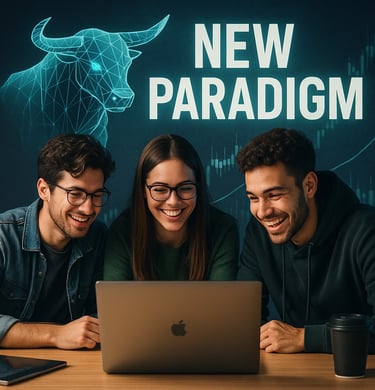A New Paradigm in Geopolitics and Markets
7/6/20254 min read


Over the past quarter, the global economic and political environment has been defined by turbulence, transitions, and transformation. While monetary policy and corporate earnings continue to matter, geopolitical conflict—particularly the Israel–Iran confrontation—briefly took center stage. For several months, global risk appetite shrank, and safe-haven flows spiked as the conflict risked escalation across the region. However, in the end, it was not just firepower but intelligence—artificial intelligence—that played a decisive role.
The United States and Israel demonstrated a strategic and technological superiority on the battlefield. AI-powered surveillance, real-time drone coordination, predictive targeting systems, and data-driven battlefield analysis played a crucial role in neutralizing threats and intercepting attacks. Palantir Technologies, one of the key enablers in this evolution, experienced a significant surge in both valuation and investor interest. Its Gotham and Foundry platforms, used in defense and intelligence, once again confirmed that the frontier of modern warfare lies not in sheer size, but in computational dominance.
The Middle East situation has since de-escalated to a degree. However, the lessons are profound: defense is now defined by data, AI, and automation. As military doctrines around the world adapt to this new reality, companies enabling secure, scalable AI systems are poised for long-term growth. This is one reason I maintain my strategic interest in firms like Palantir, despite volatility in broader risk markets.
Meanwhile, a new threat has emerged—not one of missiles, but misinformation. During the conflict, Iran and China employed state-driven disinformation campaigns, leveraging deepfake technology, AI-generated voices, and synthetic video to shape perception and sow chaos. This not only challenged the credibility of on-the-ground journalism but also undermined trust in publicly reported data. In light of these developments, I’ve decided to fully divest from Chinese equities. While companies like Pinduoduo show operational promise, the broader environment lacks transparency and credibility. Financial reports, earnings calls, and even regulatory disclosures can no longer be taken at face value. Given the fragility of China’s real estate market and the structural weaknesses in consumption growth, I see better opportunities elsewhere—particularly in Nasdaq-listed firms with clear governance standards.
Turkey, unfortunately, follows a similar autocratic trajectory. President Erdoğan, once thought to be politically invincible, is now trailing in polls behind Istanbul Mayor Ekrem İmamoğlu. In response, the regime has escalated its crackdown on opposition figures. Recent arrests, including that of İmamoğlu and other metropolitan mayors, have shocked the public. The erosion of rule of law and civic institutions not only weakens democratic norms but severely undermines investor confidence. Without political reform, sustainable economic improvement remains unlikely. Inflation remains sticky, foreign direct investment is sluggish, and macro fundamentals are deeply fragile.
On the U.S. front, headlines were recently dominated by a public clash between Donald Trump and Elon Musk. The latter has hinted at forming a third political party, intensifying his role in American politics. While Tesla remains a technological leader, I am reducing exposure. Musk’s political entanglements have made Tesla’s risk profile harder to assess. Policy unpredictability now factors into what should be an engineering-driven growth story. Volatility, both market and non-market, remains elevated.
The macroeconomic backdrop is also evolving. The Federal Reserve has kept policy rates elevated, despite clear signs that real inflation has cooled. CPI-adjusted yields suggest a highly restrictive environment, which I believe is no longer justified. The Fed’s reluctance to cut rates is arguably tipping the economy into a policy-induced recession. However, this is unlikely to last. Jerome Powell is expected to step down soon, and in the event of a Trump presidency, a more accommodative Fed chair is highly probable. I expect the first rate cuts to begin within the next two quarters.
When that happens, interest-sensitive sectors—especially real estate and luxury furnishings—will reflate. One of my core long-term holdings, RH (formerly Restoration Hardware), stands out as a prime beneficiary. The company’s fundamentals are solid, and its high-end design positioning offers resilience in an otherwise discretionary market. Should borrowing costs decline, I expect RH to re-rate significantly. As such, I am increasing my position and view this sector as an asymmetric opportunity.
It is important to note that liquidity conditions remain abundant. Despite high rates, global capital continues to seek yield, and cash balances in institutional portfolios are still near multi-decade highs. As soon as rate guidance shifts, these funds are likely to rotate aggressively into equities. Critics argue that equities are overvalued compared to historical multiples—P/E, P/S, EV/EBITDA—but this view ignores structural shifts. This is a new investment cycle. Forward-looking valuation models must account for AI-driven productivity gains, leaner cost structures, and global capital flow asymmetry.
In fact, the market has seen a generational power shift. Young retail investors—tech-savvy, risk-tolerant, and forward-looking—have begun to outperform traditional hedge funds. Many institutional players underestimated high-growth names and mistimed short positions. Meanwhile, individual investors embraced volatility and captured upside in companies like Palantir, Nvidia, and others. The tables have turned: hedge funds are now updating their models to keep up with retail momentum, not the other way around.
Looking ahead, my portfolio strategy emphasizes innovation, liquidity, and data advantage. I am building positions in companies like Rocket Lab (space logistics), Hims & Hers Health (telehealth), Oscar Health (AI in insurance), and EOS Energy (grid-scale energy storage). These are high-risk, high-reward plays, but in a macro environment transitioning toward lower interest rates and tech-led productivity, I find them compelling.
We are not just in a new cycle—we are in a new paradigm. Investors who recognize the structural shifts and adjust their frameworks accordingly will not only survive but thrive.
